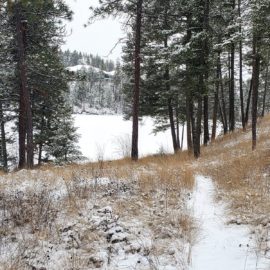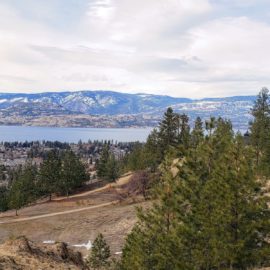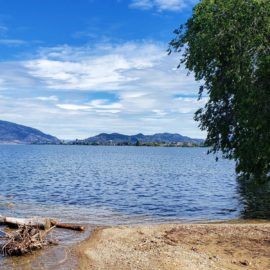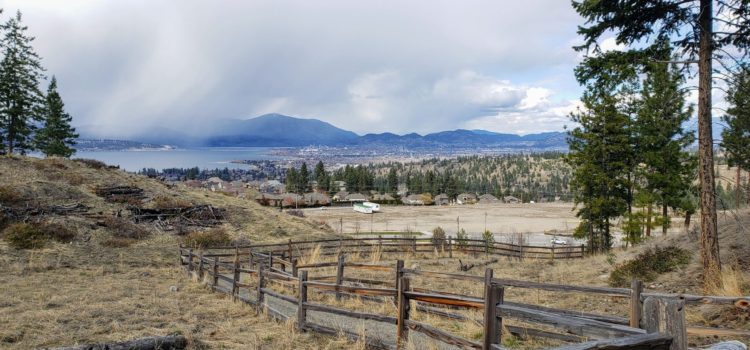
Kelowna Parks Challenge – Trip #33
This week, as part of my Kelowna Parks Challenge, I visited five parks in Kelowna’s Upper Mission. Located east of Kettle Valley, which I visited on Trip #27, this week’s area is at the top of the South Ridge of the Bellevue Valley, extending south to the foothills of Kuiper’s Peak.
Read on for my impressions and reflections.
The Trip
As I wrote in my Trip #29 post, where I climbed the Mission’s north ridge, the Okanagan Mission community is built on the delta of Bellevue Creek. Down on the triangular plain adjacent to the mouth of the creek, settler people have been living and building for over a hundred years, but up on the terraces at the top of the ridges, settlement has been generally sparse until recently.
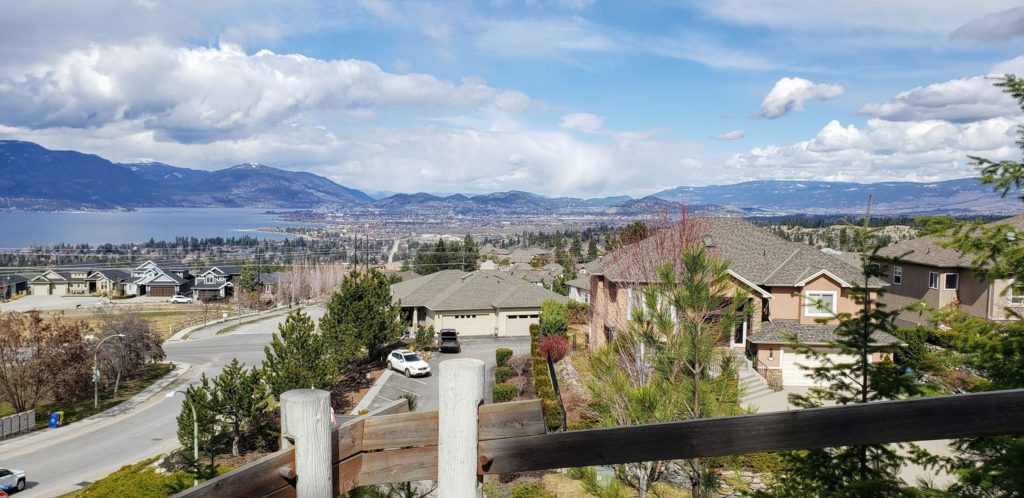
On top of the south ridge, in particular, subdivision and extensive development has only been going on for the last couple of decades and isn’t finished, according to current plans. The development of the Kettle Valley neighbourhood began in the mid-1990s and the development of the Southridge neighbourhood I explored this week began about ten years later. Further to the east, the Ponds neighbourhood was begun about ten years after that, and I’m looking forward to exploring it in an upcoming adventure.
Just like in Wilden, also still under development, this week’s neighbourhood was subdivided with conservation in mind. Especially when it comes to the steeper areas, streets are built to conform to the curves of the landscape, hillsides are left as parkland, and hidden forest ponds are preserved and repurposed for stormwater detention. Though this inevitably results in a fragmented and degraded environment for local wildlife, it at least preserves enough of it for that wildlife to persist.
Quarry Park
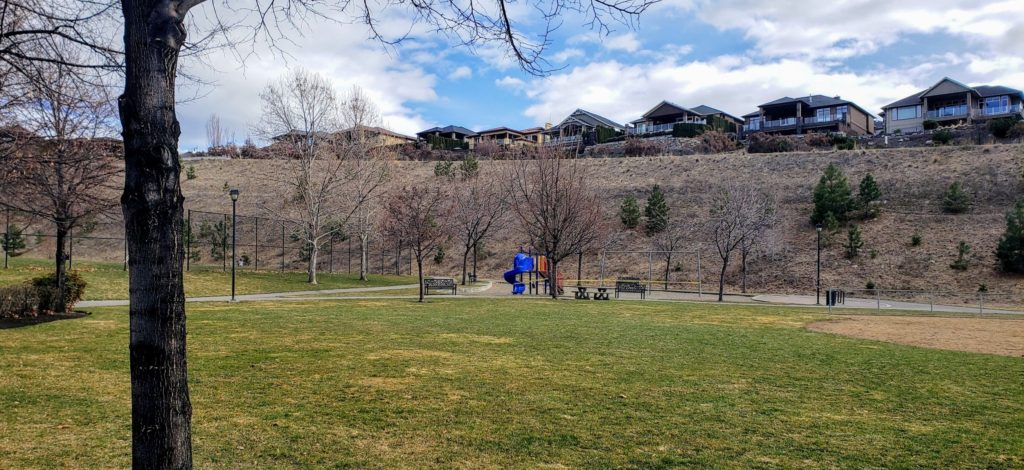
This park is located part of the way up the south ridge. It was built about fifteen years ago, along with the rest of the neighbourhood, and a plaque at the park’s east end commemorates its use as a staging area for responders to the 2003 Okanagan Mountain wildfire.
This is a large park, with room for a soccer field as well as a playground and baseball diamond. A paved path runs around the outer edge. Since it is carved out of the hillside, the south side of the park is a very steep hill, and the view from the top is excellent.
Washrooms and Drinking Fountains: There is no drinking fountain in this park. There is no washroom in this park.
Dog Rules: On-leash dogs are allowed on the trails in this park.
Powerline Park
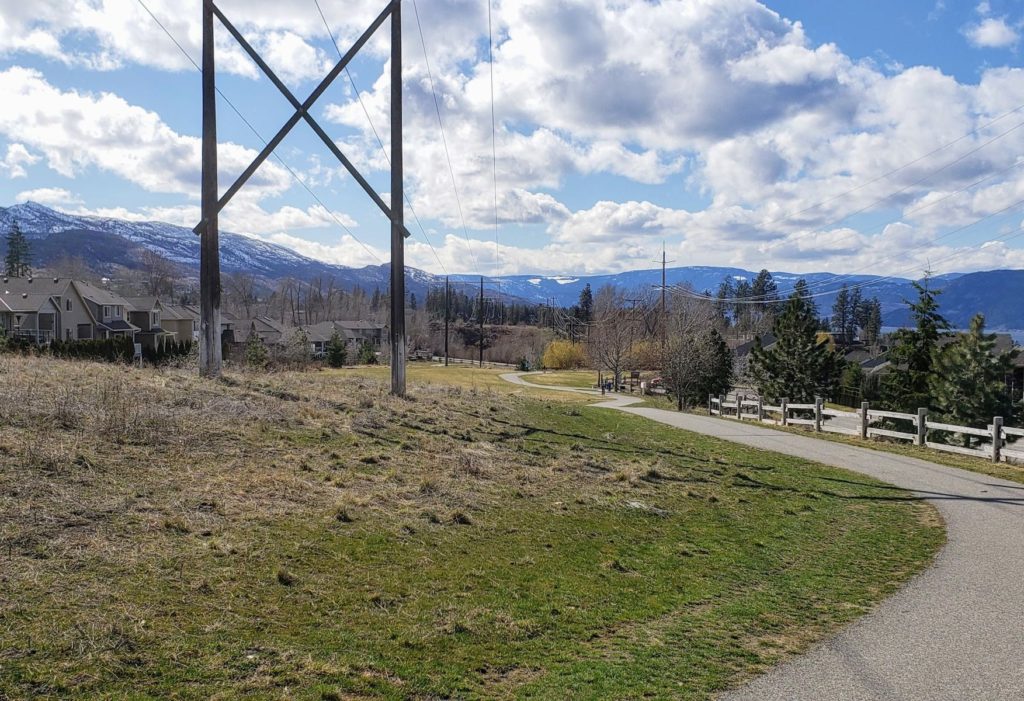
This is another park planned and developed along with the rest of the neighbourhood, fifteen years ago. The powerlines, of course, have been here for many more years than that, but from 2007 to 2011, paths, plantings, and other features were installed beneath them, creating a wonderful recreational option for local residents.
The park makes a great place to go for a walk, and isn’t done yet. Just last year, the segment on the northwest corner of Frost Road and South Ridge Drive was developed, and the city would like to extend the park further west, across Killdeer Road to Chute Lake Road.
Washrooms and Drinking Fountains: There is a drinking fountain in this park, at the Bunting Court entrance in the western part of the park. There is no washroom in this park.
Dog Rules: On-leash dogs are allowed on the trails in this park.
Southridge Park
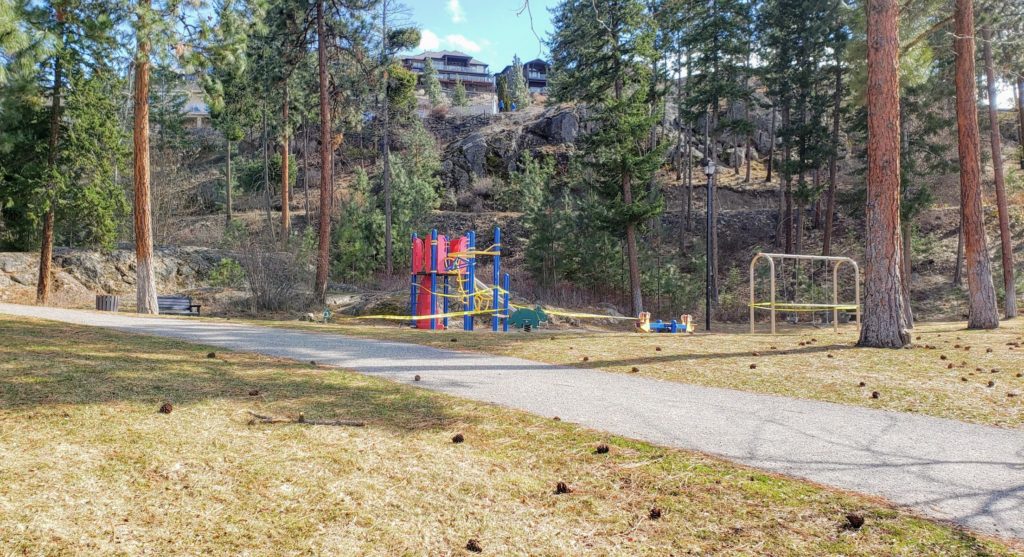
This is a beautiful little neighbourhood park, made better by being attached to a wonderful natural space. Like a lot of neighbourhood parks, its main features are a playground, a picnic table, a bench, and a lawn, but unlike in most neighbourhood parks I have visited, here those features are surrounded by a lovely pine forest, rather than just suburban houses.
This park is a great place for locals of all ages to pause, even if they only see it as an entry point to the larger park beyond.
Washrooms and Drinking Fountains: There is no drinking fountain in this park. There is no washroom in this park.
Dog Rules: On-leash dogs are allowed on the trails in this park.
Southridge Detention Pond and Open Space
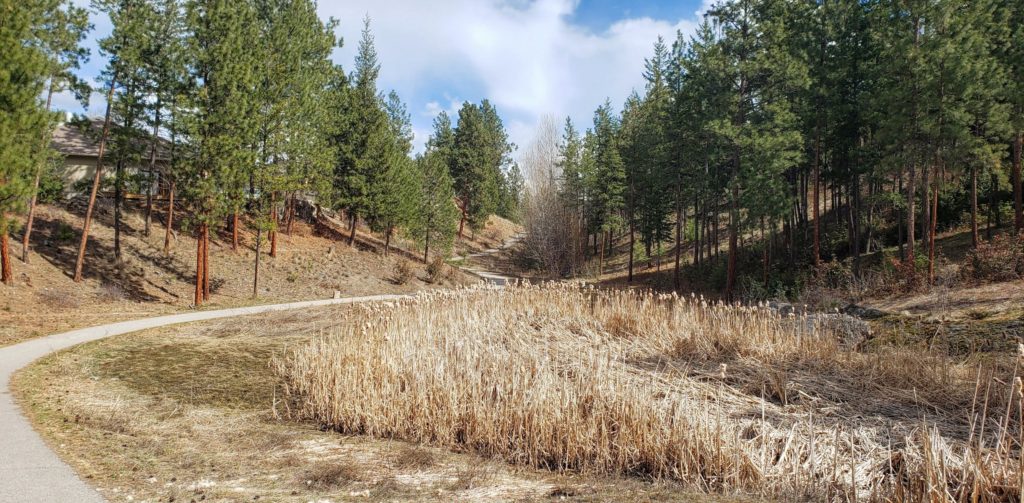
This is another park, the main purpose of which is to provide important city infrastructure. In this case, a natural valley with natural ponds has been adapted to accommodate seasonal floodwaters. Though some feel this might damage the native ecosystem, I prefer to focus on what has been preserved. Here in the middle of a modern subdivision, is a green corridor for local wildlife to use to continue to travel through their newly colonized territory. During my visit, for example, I spotted a yellow-bellied marmot.
Though this park doesn’t have any special features, such as benches or picnic tables, it’s central path provides a wonderful place to take a peaceful forest bath.
Washrooms and Drinking Fountains: There is no drinking fountain in this park. There is no washroom in this park.
Dog Rules: On-leash dogs are allowed on the trails in this park.
Frost Road Open Space
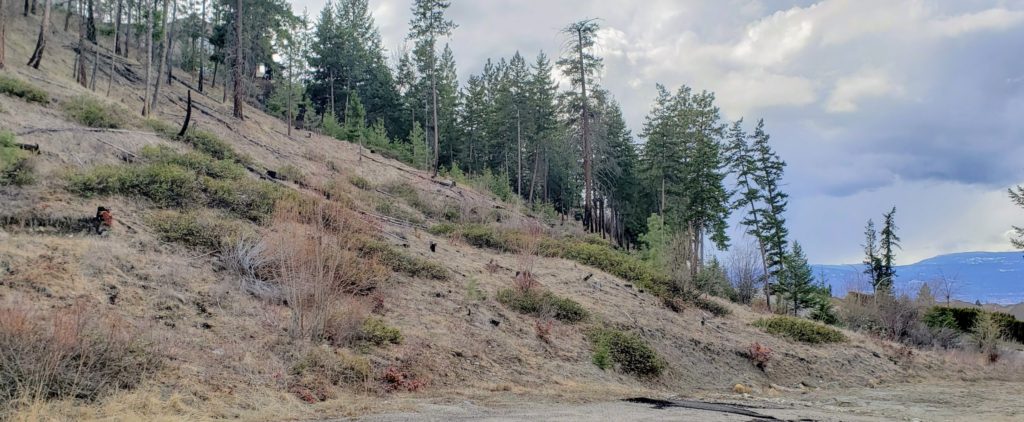
This park is even less-developed than the previous one. Essentially a preserved hillside, this park has no features whatsoever. There is not even a trail through it.
Its main attraction might be the view to the north that can be seen from the sidewalk that runs along its north side. By far the best I found on this trip, it gives a completely unhindered view over nearly the entirety of Kelowna.
Washrooms and Drinking Fountains: There is no drinking fountain in this park. There is no washroom in this park.
Dog Rules: On-leash dogs are allowed in this park.
Reflections
Conservation-minded Subdivision Design
This week’s parks offered another opportunity to observe modern conservation-minded subdivision design at work. I still get the feeling these designers have human interests more in mind than wildlife ones, but it is nice to see any swaths of forest being protected.
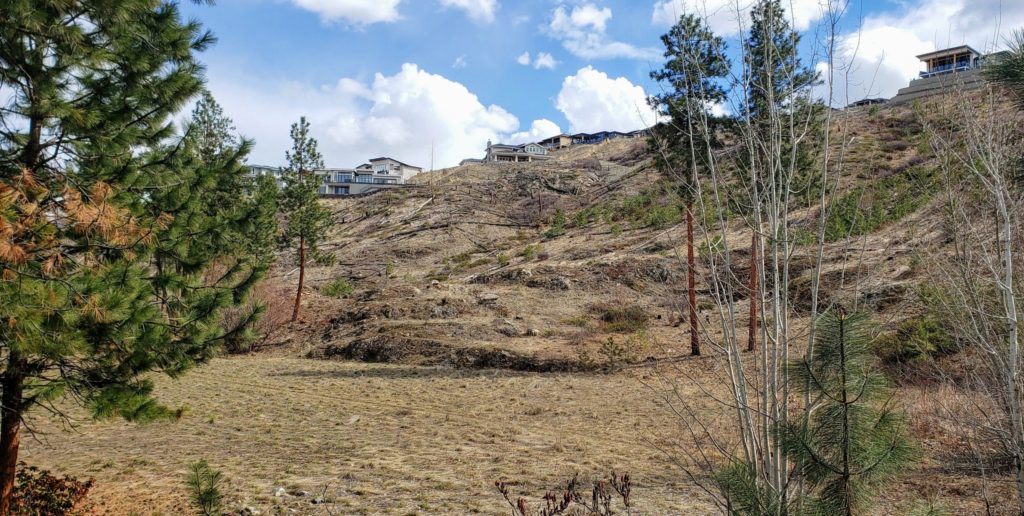
My favourite park of the week, of course, was the Southridge Detention Pond Open Space. Even though I could assume the hillside was only protected because it wasn’t feasible to build houses on it and the pond was only protected because the local floodwater needed to be managed, it was still nice to see a protected green corridor that is being used by wildlife. It was interesting, however, to see how the various dams and ditches that had been added to the valley had modified the original drainage pattern. The largest pond, in the centre of the park, has now become a meadow since water was redirected away from it.
Utility Corridor Parks
As I noticed when I explored Shetland Park, a utility corridor is almost a no-brainer when it comes to developing linear parks. Wherever there is a pipeline or a powerline, there is generally already a swath of cleared land providing a path across the landscape, and if a park hasn’t been developed there, there is almost certainly an unofficial trail there already.
Oftentimes, as with many other parks, subdivision provides the impetus for powerline park development. Just as with steep hillsides, a utility corridor is a chunk of land where houses can’t be built, so why not make it a park? In the case of Kelowna’s Powerline Park, several of the segments formerly crossed agricultural lots, and it wasn’t until those lots were rezoned as residential subdivisions that the land under the powerlines became available for park development.
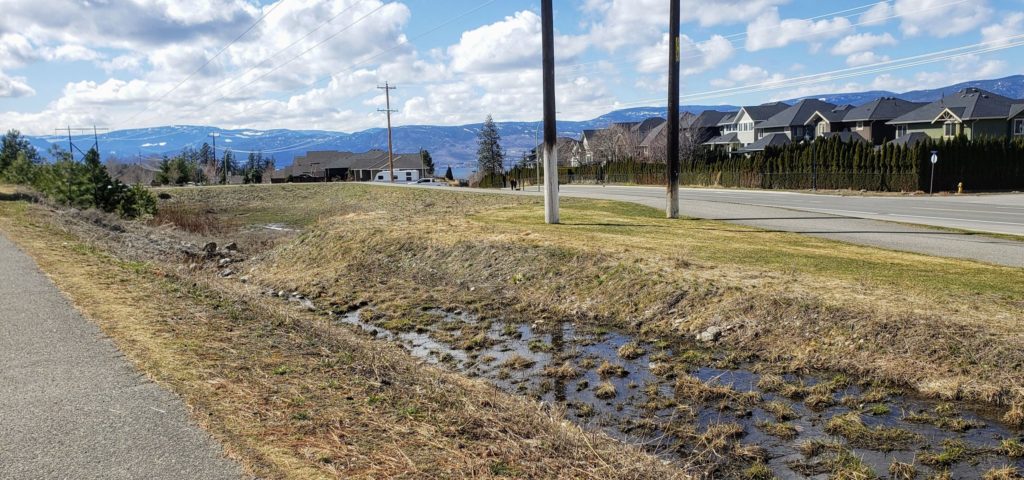
Utility corridors have limits, of course, in terms of reforestation. It would not do to have trees growing up into powerlines or have their roots growing down around pipelines. Other than that, however, these corridors provide an excellent opportunity to double as green corridors for local wildlife movement. Kelowna’s Powerline Park is was developed between 2007 and 2011, and the plantings are still growing in, but I was pleased to see that opportunities to plant trees along the sides were not ignored. Also, I enjoyed seeing the series of detention ponds and connecting creeks that had been built to handle the overflow of water from the Southridge Detention Pond Open Space. Efforts appear to have been made to naturalize this infrastructure as much as possible.
Conclusions
With the addition of these five parks, I have now seen one hundred forty-five of the two hundred three parks on my official list in two hundred fifty-four days, or 71% of the parks in 70% of the days. The gap is widening slowly, which is exactly what I want.
Public health directives regarding the ongoing pandemic still allow for outdoor exercise but they are trending towards curtailing widespread wandering and unnecessary travel. Though I remain asymptomatic, it is more and more clear that there are many asymptomatic carriers of this disease. I continue to keep physical distance between myself and everybody else as I explore, but there might come a time when I am persuaded to suspend my project. I will let you know.

